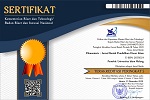PENGARUH METODE WAFA TERHADAP KEMAMPUAN ANAK MEMBACA AL-QUR’AN DI MI AL-HIDAYAH MANGKUJAJAR KEMBANGBAHU LAMONGAN
DOI:
https://doi.org/10.33474/elementeris.v1i1.2769Abstract
The Qur'an learning is very fundamental in Islamic education, especially in elementary education. The Qur'an is one of the subjects that must be taught to children. Early education in the Qur'an is expected to produce young people having a strong mental foundation, education not only makes children as prosperous in the world, but also provides sufficient provisions to both improve their religion and practice their scriptures. To be able to practice the Holy Qur'an correctly, children must be guided and taught how to read the Qur'an properly in accordance with the rules of true recitation. In fact the Qur'an learning at MI AL-Hidayah Mangkujajar Kembangbahu Lamongan initially tended to be monotonous for being dominated by conventional learning methods. As a result, the Qur'an learning only produced generations that could read the Qur'an with the average ability without any sense of love and closeness to the Qur'an instead of having enthusiasm in learning it well. As time goes by, the Qur'an learning at MI Al-Hidayah has increasingly developed by applying the so-called Wafa method. This method teaches children to be able to read and memorize the Qur'an by maximizing the right brain. This is classified as a new method, but it is quite practical and fun in the learning process. The research was aimed at determining the effect of the Wafa method on the ability of children to read the Qur'an at MI Al-Hidayah Mangkujajar Kembangbahu Lamongan. The research method is quantitative with the experimental type of one group pretest-post test, data analysis techniques use the mean pretest and posttest, in addition, to testing the hypothesis it uses the Paired Sample T-Test with the SPSS 16. The results showed the influence of the Wafa method on the children ability to read the Qur'an at MI Al-Hidayah Mangkujajar Kembangbahu Lamongan. It was proven from the results of the analysis through the mean pretest formula, it was obtained a value of 82.92 and increased in the acquisition of the mean value of posttest amounted to 85.75. In addition, in the Paired Sample T-Test based on significance values with SPSS 16, it is known that the Sig. (2-tailed) value is 0,000 <0,05, because sig. (2-tailed) of 0,000 is smaller than 0.05, then the hypothesis is accepted and it could be concluded that there is an influence of the WAFA Method on the ability to read the Qur'an at MI Al-Hidayah Mangkujajar Kembangbahu Lamongan.References
Arifin, Gus. (2009). Membuka Pintu Rahmat dengan membaca Al-qu’an. Jakarta Timur: Zikrul Hakim
Arikunto, Suharsimi. Prosedur Penelitian.Jakarta : Rineka Cipta, 2006,
Azra, Azyumardi. (2002). Ensiklopedi Islam Jilid 4. Jakarta : PT Ichtiar Baru Van Hoeve.
Daniel Muijz & David Reynolds. (2008). Effective Teaching: Teori dan Aplikasi (terj.). Yogyakarta: Pustaka Pelajar.
Kementrian Agama RI. (2012). Aljamil Al-Qur’an Tajwid Warna, Terjemah Per Kata, Terjemah Inggris. Bekasi: Cipta Bagus Segara.
Rohani, Ahmad. (2004). Pengelolaan Pengajaran. Jakarta: Rineka Cipta.
Shihab, Quraish. (2004). Membumikan Al-Qur’an: Fungsi dan Peran Wahyu dalam Kehidupan Masyarakat. Bandung: PT Mizan Pustaka.
Shoimin, Aris. (2014). 68 Model Pembelajaran Inovatif dalam kurikulum 2013. Yogyakarta:Ar-ruzz Media.
Siti Rohmaturrosyidah Ratnawati dan Imrotus Solihah. (2017). Pembelajaran Al-Qur’an metode wafaâ€, Jurnal akademika, vol. 2, No 1.
Sugiono, Metode Penelitian. (2015). Bandung: Alfabeta.
Syarifuddin , Ahmad. (2004). Mendidik Anak Membaca, Menulis, dan Mencintai Al-Qur’an. Jakarta: Gema Insani.
Tim Wafa. (2013). Wafa Belajar Al-Qur’an Metode Otak Kanan Ghorib Musykilat. Surabaya: Yayasan Safaatul Qur’an Indonesia.
Usman, Moh. Uzer. (2006). Menjadi Guru Professional (Bandung: PT Remaja Rosda Karya.
Sugono, Dendy. (2011). Buku Praktis Bahasa Indonesia Jilid 2. Jakarta: Badan Pengembang dan Pembinaan Bahasa.
Downloads
Published
Issue
Section
License
The journal operates an Open Access policy under a Creative Commons Non-Commercial 4.0 International license. Authors who publish with this journal agree to the following terms:
- Authors retain copyright and grant the journal right of first publication with the work simultaneously licensed under a Commons Attribution-NonCommercial 4.0 International License
that allows others to share — copy and redistribute the material in any medium or format, and adapt — remix, transform, and build upon the material.
- Authors are able to enter into separate, additional contractual arrangements for the non-exclusive distribution of the journal's published version of the work (e.g., post it to an institutional repository or publish it in a book), with an acknowledgement of its initial publication in this journal.
- Authors are permitted and encouraged to post their work online (e.g., in institutional repositories or on their website) prior to and during the submission process, as it can lead to productive exchanges, as well as earlier and greater citation of published work.
Elementeris: Jurnal Ilmiah Pendidikan Dasar Islam by Universitas Islam Malang is licensed under a Creative Commons Attribution-NonCommercial 4.0 International License.
Based on a work at http://riset.unisma.ac.id/index.php/je/index.















